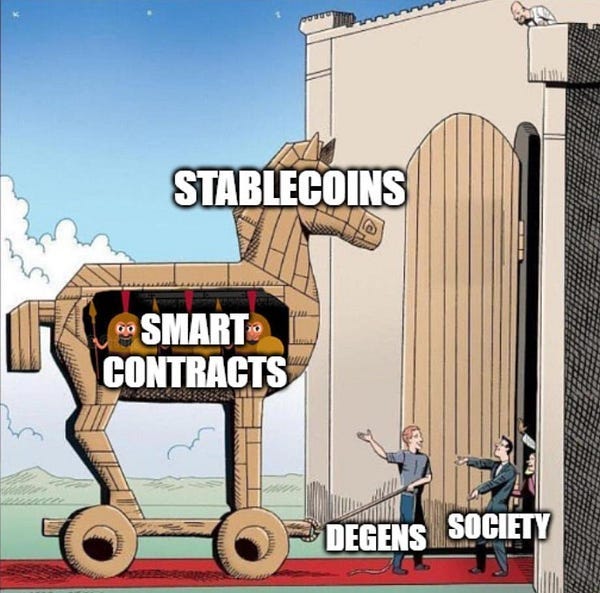As part of my next installment, the first installment here, I try to follow up on Starknet use cases. But I’ve read a whitepaper about a new protocol designed by the Coinbase team that blew my mind, I think that combining it with technologies like Starknet can be a game-changer. You’ll remember Starknet as Ethereum’s answer to the question, “How do we make this thing actually usable without selling a kidney to pay the gas fees?” That’s right, Starknet uses zk-STARK wizardry to make transactions fast, secure, and, most importantly, not financially ruinous. It’s the magic carpet that lets decentralized apps (dApps) soar above the clogged traffic jam that is Ethereum mainnet, all without sacrificing security or compatibility. Starknet means thousands of transactions per second, fees you can actually afford, and development tools that don’t make you want to throw your laptop out the window.
Para leer la versión en Español aquí
Last time, we marveled at how Starknet powers everything from blockchain gaming and advanced DeFi to decentralized social networks, each one benefiting from those sweet, sweet low costs, scalability, and security. We also talked about how developers can build complex, feature-rich experiences while users get to enjoy lightning-fast, affordable interactions. Imagine: a blockchain that doesn’t feel like dial-up internet. Revolutionary!
What’s on the agenda today?
Today, we’re turning the dial up a notch:
We’ll give Starknet a quick encore, because it deserves it.
We’ll explain why Coinbase’s x402 whitepaper made us question everything we thought we knew about web payments (and possibly reality itself).
We’ll show how x402 and Starknet together could finally make paying for things online not just tolerable, but actually… pleasant?
And yes, we’ll close with real-world examples—because we’re not just dreamers here.
Coinbase x402: The missing link for web payments (that’s not just another subscription)
So, what is x402? It’s an open protocol from Coinbase that lets you make instant stablecoin payments (think USDC) directly over HTTP, using the “402 Payment Required” status code. Yes, that’s the same 402 code that’s been a running joke among developers for decades, like the “Reserved for Future Use” sign on a bathroom door that never actually gets installed. Well, the future just showed up, and it accepts stablecoins.
With x402, any API, app, AI service, or digital platform can demand a payment before giving you access automatically, programmatically, and without the usual “please enter your credit card and mother’s maiden name” routine.
Here’s the kicker: Payments can be made by humans or software agents. That’s right, your bot can now pay another bot for data, services, or, presumably, for a shoulder to cry on when the singularity hits. No human intervention, no friction, no “Sorry, your card was declined.”
This isn’t just efficient, it’s a minor miracle. It enables global micropayments, cuts out the middlemen, and finally makes “pay-per-use” business models viable, instead of just a pipe dream for frustrated developers.
Why does this matter for Starknet?
Starknet, as a Layer 2, already makes transactions fast and cheap. But add x402 to the mix, and suddenly:
- Developers can monetize APIs, games, digital content, or AI services with real-time, frictionless stablecoin payments.
- Autonomous machine-to-machine payments become reality, so your fridge can finally pay your toaster for that extra slice of toast—no humans needed.
- Apps can reach more users, because anyone with a wallet and stablecoins can interact, no matter where they are or how many banks have told them “no.”
Use cases that are already real (and not just in a whitepaper)
On-chain gaming: Games on Starknet can charge per match, skin, or premium resource via x402, enabling seamless and automatic micropayments. No more “buy 1,000 gems for $99.99”—just pay for what you use, when you use it.
- Decentralized Social Networks: Users can pay pennies to post, access premium content, or tip creators, instantly and without signing up for yet another subscription they’ll forget to cancel.
- AI-as-a-Service: AI agents pay for each query or inference using stablecoins, handling payments autonomously and in real time. The robots are literally paying each other now.
- APIs and data: Platforms can charge for each API call or data access, enabling granular, global business models. Finally, data providers get paid without having to sell their soul or their data to advertisers.
Final thoughts
The combination of Starknet and x402 doesn’t just solve technical problems of scalability and cost, it redefines how value is exchanged online. If the first wave of Web3 brought decentralization, the next, with Layer 2s and protocols like x402, will bring automatic, global, and programmable payments for both humans and machines.
So buckle up: the future of the internet might actually be convenient. Who saw that coming?




